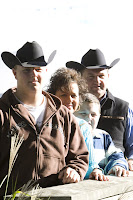I went to my first cutting finals this evening at Silverado on the Brazos in Weatherford, Texas. Now I have to admit that despite my 13 some odd years of showing horses, I am definitely a cutting horse virgin. I know that it involves horses and cows, but beyond that, I have very little knowledge of this side of the horse world. However, from watching videos and speaking to a few top competitors I have learned a little something.
To begin, a horse and rider get two and a half minutes to exhibit their skill at separating two to three cows from the herd. Secondly, a run can be judged on criteria like correctness, eye appeal and amount of time actually spent cutting each cow. Thirdly, they compete for a whole lot more money than we do.(Meaning the pleasure horse industry in general) In fact, someone once told me that the cutting horse business is a close second to thoroughbred racing, when it comes to amount of money produced and transferred within the industry. I believe the figure reaches approximately $35 million in prize money given out per year. At the Brazos Bash this week, there will be $285,000 in added money up for grabs to those who can combine their superior skill and technique with some cooperative cows, a willing horse and a whole lot of luck. Now when you divide that up per capita, per cow, per cut, there’s a lot at stake when entering the pen for those two and a half minutes, or 150 seconds, whichever way you look at it.
But don’t be mistaken, it isn’t all about the money. On the contrary, even with a lot more at stake, the cutters seem to have developed much more camaraderie with each other than another other equine discipline I have been a part of. In fact, I felt more welcome there, than at some of the horse shows I have been going to for years. Now granted, this could be attributed to the fact that I enter their world as a spectator and not an exhibitor. However, my personal opinion is that they seem to have written the book on how to compete and (Gasp) socially interact with each other in a friendly manner.
Case in point, when a cutter goes to the herd to select his first cow, he/she has about four other riders in the pen serving as the “turn back” crew. Their job it is to help contain the rest of the herd, help the competitor locate his/her cow of choice and generally to give the competitor his/her best chance at performing successfully. Now, each competitor can select the people who will be in his/her turn back crew, but more often than not, these riders are competing in the same classes with each other. Therefore, the scenario is often that one person may complete their run and turn right back around and go in the pen to help their competitor as part of their turn back crew. That’s right people, I did say help their competitor. While this idea may seem foreign to some, it seems to be working quite well for the people in the cutting industry and might be something interesting we each could try implementing in our own respective disciplines.
Another observation is that cutters generally do not wear numbers. The order of go is often posted the day before and each rider and horse combination is announced as they enter the pen to work. Now, some people might think that this practice could increase the likelihood of judges playing politics, where the big name riders receive leniency or favoritism. However, there are two additional methods that are used to counteract the possibility of nepotism. First, cutting is a scored event, which serves to eliminate much of the objectivity in the first place. Second, judges sit high atop a white platform (an ivory tower if you will) each in his/her own little cubicle when the scoring takes place. At the end of each run, the judges’ scores are tabulated and immediately posted on a scoreboard. While no system is without its flaws, this procedure seems to keep most people happy.
One of the best parts is to watch these athletic equines crouch down on all fours and contort their bodies into seemingly impossible positions to prevent a cow from escaping back to their bovine buddies. It’s no wonder these animals are likened to being as “smooth as a cat.” Action photographs or slow motion video taken head on exhibit this view to the utmost. It’s truly incredible to see a horse rocked back with its hocks buried in the dirt ready to launch in either direction at any imperceptible movement of the cow.
As far as results are concerned, tonight’s winner of the three year old open was Phil Rapp on Iced Out with a score of 220. Rapp’s check was for $17,500.00. Winning reserve was Clint Allen riding Chiefs Hawkeye with a 219. In the five and six year old open, Jason Clark on Wise Little Miss won and Paul Hansma with Cats Little Tank was reserve. Clark took home a check for $20,000.
Be sure to stay tuned to receive updates from the Brazos Bash during this week. Who knows, maybe this die hard all-around competitor might add a new event to her repertoire…













